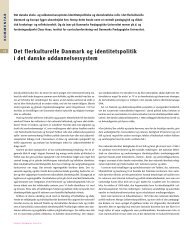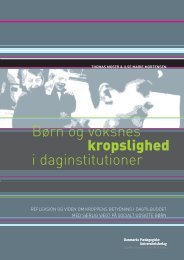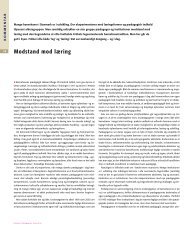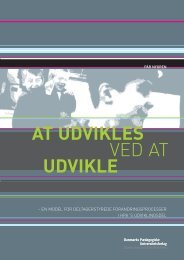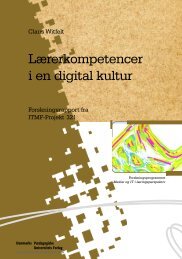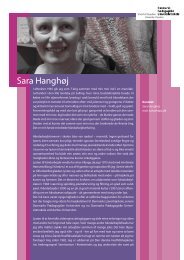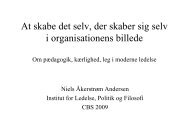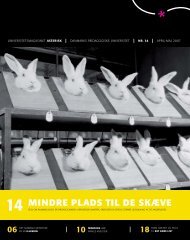SRI-Teknisk rapport-sen.v13 - DPU
SRI-Teknisk rapport-sen.v13 - DPU
SRI-Teknisk rapport-sen.v13 - DPU
Create successful ePaper yourself
Turn your PDF publications into a flip-book with our unique Google optimized e-Paper software.
out measurement of outcome - if relevant? variables were examined through questions in the<br />
questionnaire:<br />
classroom instruction and assessment practices,<br />
student learning and motivation, students' and<br />
teachers' beliefs about and attitudes toward the<br />
assessment, and a school characteristic.<br />
K.9 Where were the data collected? Educational Institution (please specify)<br />
Section L: Methods - data analysis<br />
L.1 What rationale do the authors give for the<br />
methods of analysis for the study?<br />
114<br />
Details<br />
Random coefficient<br />
or growth models were used to examine MSPAP<br />
performance from 1993<br />
to 1998 in relation to variables derived from the<br />
teacher and student questionnaires,<br />
and the school characteristic of percentage of free<br />
or reduced-price<br />
lunches, which served as a proxy for SES. These<br />
methodologies are<br />
particularly well suited for studying processes in<br />
which change is considered to<br />
be continuous but individual differences occur in<br />
the pattern of change (i.e.,<br />
initial level and rate of change). Further, these<br />
methodologies allow identification<br />
of factors that affect the patterns of change. This<br />
type of analysis cannot be<br />
modeled by time-specific comparisons involving<br />
group-level (i.e., means)<br />
differences<br />
L.2 Which methods were used to analyse the data? Explicitly stated (please specify)<br />
Sets of items on the teacher questionnaire were<br />
combined and validated by using<br />
confirmatory factor analytic (CFA) methods and<br />
measures of internal consistency<br />
to reflect the dimensions described in the following<br />
list (e.g., Lane, Stone,<br />
Parke, Han<strong>sen</strong>, & Cerrillo, 2000). For the purposes<br />
of the CFA, subsets of items<br />
were combined to form two indicators for each<br />
dimension (about equal numbers<br />
of items) except the MSPAP Impact dimension. For<br />
this dimension, only one indicator<br />
was used because the items could not be divided<br />
into two meaningful components.<br />
The indicators within each dimension are also given<br />
in the following list,<br />
as is the total number of items for each dimension,<br />
which varied to a small degree



